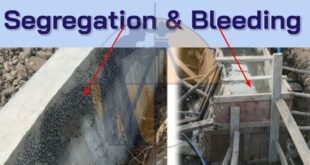How to Create The Design Of RCC Structures With Details

-
- A Reinforced Concrete Slab is treated as one of the most crucial elements in a building structure. This structural element is mostly found in modern buildings. Slabs are rested on Columns and Beams.
- RCC Slabs whose thickness varies from 10 to 50 centimeters are mostly recommended for building up the floors and ceilings.
- For developing exterior paving, thin concrete slabs are very useful.
- In several domestic and industrial buildings a condensed concrete slab that is rested on foundations or directly on the sub soil, is applied for building up the ground floor of a building.
- In high reaching buildings and skyscrapers, slimmer, pre-cast concrete slabs are suspended among the steel frames to build up the floors and ceilings on every level.
Learn More
-
Segregation And Bleeding In Concrete Work
-
What are the Common Excavation Hazards And Their Prevention
-
What is Steel Fiber Reinforced Concrete
- When structural drawings of the reinforced Concrete Slab are formed, the slabs are shortened to “R.C slab” or simply “R.C”.
How to create the design of different types of slabs and their reinforcement
Toward a suspended slab, there are numerous designs for enhancing the strength-to-weight ratio. In every situation, the top surface keeps on flat, and the footing is adjusted:
- Corrugated, generally, when the concrete is poured into a corrugated steel tray. It makes the durability of concrete superior and avoids the slab to bend under its own weight. The corrugations happen on the short dimension, from side to side.
- A ribbed slab – it provides significant additional strength on one direction.
- A waffle slab – it provides additional strength in both directions.
Reinforcement design.
- A one way slab contains structural strength in shortest direction.
- A two way slab contains structural strength in two directions.
These slabs vary from cantilevered or Simply Supported Slabs.
Construction.
- A concrete slab is casted in two different ways like prefabricated or cast in suit.
- In a factory, prefabricated concrete slabs are casted and then carried to the job-site dropped into place among steel or concrete beams.
- These are pre-stressed (in the factory), post-stressed (on site), or unstressed. In order to get rid of the problem for fitting the slabs across the supporting structure, the supporting structure should be developed with exact dimensions.
- In suit concrete, slabs are developed with the construction site through form-work. Form-work stands for a box-type setup in which the pouring of concrete is done for building up the slabs.
- Toward reinforced concrete slabs, reinforcing steel bars are arranged inside the form-work and then the pouring of concrete is started.
- Plastic tipped metal, or plastic bar chairs are utilized for retaining the reinforcing steel bars apart from the bottom and sides of the form-work, with the intention that if the concrete is arranged, it entirely covers the reinforcement.
- Form-work deviates with the kind of slab. Toward a ground slab, the form-work is built up with sidewalls pushed into the ground while for a suspended slab, the form-work takes the shape like a tray, frequently supported with a temporary scaffold unless the concrete is placed.
Other Post
-
What is Differences Between One Way And Two Way Slab
-
What Is Difference between Site Engineer And Civil Supervisor
 Surveying & Architects A unique platform of Civil Engineering
Surveying & Architects A unique platform of Civil Engineering

One comment
Pingback: Basic Thumb Rules For Civil Engineers - Surveying & Architects